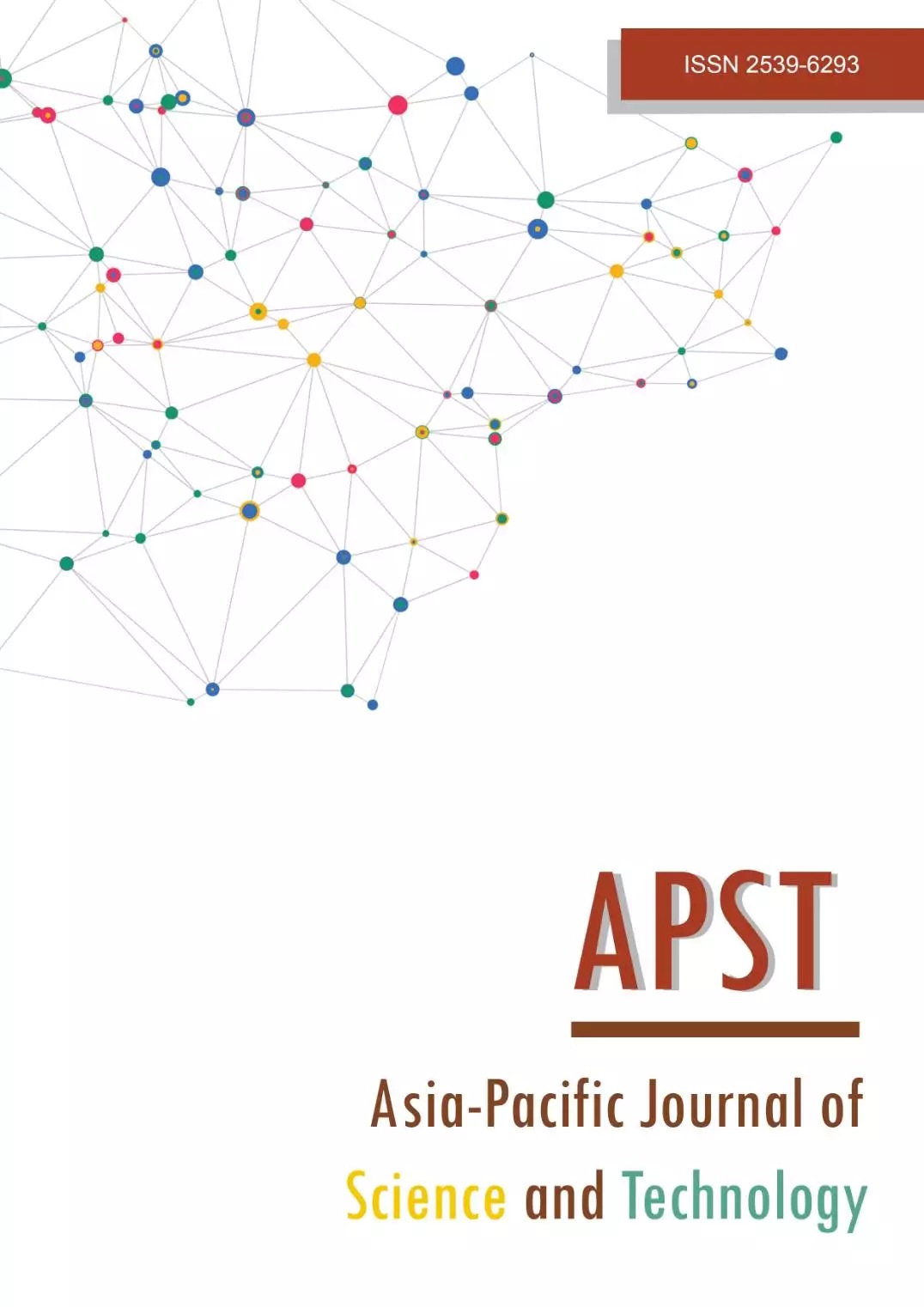Thermal transmission reduction through bio-based insulated walls, weather-based data analysed for passive cooling in tropics
Main Article Content
Abstract
An experimental and analytical investigation on the potential of bio-based insulation on heat transmission reduction and natural ventilation for passive cooling in the tropics was carried out. Thailand has a tropical climate that is commonly hot and humid all year around. Wall insulation can reduce heat transmission into buildings, resulting in lowering energy demand for cooling as well as providing occupant comfort. Biologically based insulations can be employed to not only provide good thermal characteristics, comparable with conventional commercial products, but are also environmentally friendly. In this article, simple bio-based insulation materials were produced from bamboo fibers and blady grass fibers and their thermal conductivities were compared to commercial insulation. The thermal characteristics of insulated walls using natural fiber materials and commercial materials was tested, in a hot and humid outdoor climate, and compared. Finally, weather data from three cities in Thailand was analyzed to examine the wind speed and direction for locating the optimal building opening for passive ventilation. In brief, the bio-based insulation had quality equal to the commercial materials in terms of thermal conductivity and density, the building insulation could prevent heat gain through the walls by as much as 33% with indoor temperatures 2.4°C lower than the base case, according to the experimental results of the bamboo fiber insulation. The prevailing wind for the three case study provinces in Thailand varied depending on their topography; however, it was found the southern wind was the strongest in all three regions.
Article Details

This work is licensed under a Creative Commons Attribution-NonCommercial-NoDerivatives 4.0 International License.
References
Serasinghe SVIRV, Wijewardane MA, Nissanka ID. A study on climate change impact on cooling energy demand patterns for an existing office building. In: Dissanayake R, Mendis P, Weerasekera K, Silva S, Fernando, editors. ICSBE 2020. New York City: Springer; 2022. p.115-130.
Thai Meteorological Department. Annual weather summary [internet]. 2021 [cited 2022 Apr 1]. Available from: https://www.tmd.go.th/index.php.
Beule L, Lanhenke JF, Tantanee S. Trends in temperature in Thailand from 1964 to 2013. Asia Pac J Sci Technol. 2017;21(4):1-5.
Department of Alternative Energy Development and Efficiency (DEDE). Ministry of Energy. Air conditioning system [internet]. [cited 2022 Nov 1]. Available from http://www.dede.go.th.
Hatamipour MS, Mahiyar H, Taheri M. Evaluation of existing cooling systems for reducing cooling power consumption. Energy Build. 2007;39(1):105-112.
Boostani H, Hançer P. A model for external walls selection in hot and humid climates. Sustainability. 2018;11:1-23.
Schiavoni S, D’Alessandro F, Bianchi F, Asdrubali F. Insulation materials for the building sector: A review and comparative analysis, Renew Sustain Energy Rev. 2016;62:988-1011.
Rattanongphisat W, Dondee S, editors. Thermal insulation made from blady-grass fiber and natural rubber, The third international conference on environmental development administration 2020. 2020 Nov 28. Bangkok: National Institute of Development Administration; 2021.
Nguyen DM, Grillet AC, Bui QB, Diep TMH, Woloszyn M. Building bio-insulation materials based on bamboo powder and bio-binders. Constr Build Mater. 2018;186:686-698.
Nguyen DM, Grillet AC, Diep TMH, Thuc CNH, Woloszyn M. Hygrothermal properties of bio-insulation building materials based on bamboo fibers and bio-glues, Constr Build Mater. 2017;155: 852–866.
Fabbri K, Tronchin L, Barbieri F. Coconut fibre insulators: the hygrothermal behaviour in the case of green roofs. Construct Build Mater. 2021;266:121026.
Fiorelli J, Bueno SB, Cabral MR. Assessment of multilayer particleboards produced with green coconut and sugarcane bagasse fibers. Constr Build Mater. 2019;205:1-9.
Hirunlabh J, Khedari J, Charoenvai S. New insulating particleboards from durian peel and coconut coir. Build Environ. 2003;38:435-441.
Wei K, Lv C, Chen M, Zhou X, Dai Z, Shen D. Development and performance evaluation of a new thermal insulation material from rice straw using high frequency hot-pressing. Energy Build. 2015;87:116-122.
Patcharaphun S, Rugkwamsook P, Na-Ranong N, Somboonvit S, Prasertsak R. Thermal insulation produced from vetiver fiber and natural rubber latex. Kasatsart Eng J. 2007;61:87-94.
Asdrubali F, D'Alessandro F, Schiavoni S. A review of unconventional sustainable building insulation materials. Sustain Mater Technol. 2015;4:1-17.
Nayak L, Mishra SP. Prospect of bamboo as a renewable textile fiber, historical overview, labeling, controversies and regulation. Fash Text. 2016;3(1):1-23.
Pattanavibool R, Bphuriyakorn B, Satitwiboon W. Bamboo in Thailand. 1st ed. Bangkok: Agricultural Cooperative Federation of Thailand; 2001.
Kassim ASM, Aripin AM, Ishak N, Zainulabidin MH. Potential of cogon grass (Imperata cylindrica) as an alternative fibre in paper-based industry. J Eng Appl Sci. 2016;11(4): 2681-2686.
Subramanian CV, Divya M. Solar passive architecture cooling techniques. Int Res J Eng Technol. 2016;3(12):1388-1394.
Tuck NW, Zaki SA, Hagishima A, Rijal HB, Zakaria MA, Yakub F. Effectiveness of free running passive cooling strategies for indoor thermal environments: example from a two-storey corner terrace house in Malaysia. Build Environ. 2019;160:106214.
Michael A, Demosthenous D, Philokyprou M. Natural ventilation for cooling in mediterranean climate: a case study in vernacular architecture of Cyprus. Energy Build. 2017;144:333-345.
Liu Y, Hu H. X-ray diffraction study of bamboo fibers treated with NaOH. Fibers Polym. 2008;9:735-739.
Instruction manual and experiment guide for the PASCO scientific model TD-8561. Thermal conductivity apparatus. California: PASCO scientific; 1987.
Wakili KG, Koebel M, Kaufmann J, Derluyn H, Hofer M, Glaettli T, Modregger P, editors. Thermal conductivity of gypsum plasterboard beyond dehydration and its correlation with the pore structure. 9th International Conference on Heat Transfer, Fluid Mechanics and Thermodynamics. 2012 Jul 16-18; Dates,Malta. Malta: HEFAT; 2012.
Levinson R, Akbari H, Gartland L. Impact of the temperature dependency of fiberglass insulation R-value on cooling energy use in buildings. [Internet]. 1996 [cited 2022 Apr 1]. Available from: https://www.osti.gov/biblio/451183-impact-temperature-dependency-fiberglass-insulation-value-cooling-energy-use-buildings.
Shao H, Zhang Q, Liu H, Guo W, Jiang Y, Chen L, et al. Renewable natural resources reinforced polyurethane foam for use of lightweight thermal insulation. Mater Res Express. 2020;7:055302.
Rigid polyurethane foams property. [Internet]. [cited 2022 Apr 1]. Available from: https://pacific-insulation.com/.
Wijaya ES. Natural ventilation optimization study in mechanically ventilated studio apartment room in Surabaya. J Appl Sci Eng. 2022;25(1):141-149.


